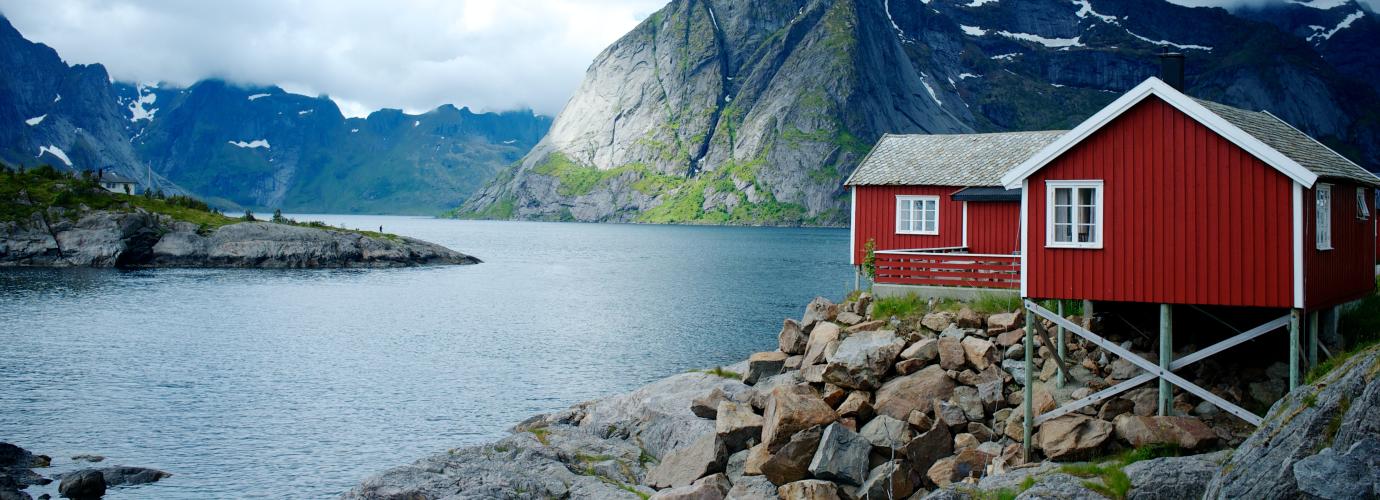Historical overview
During the Viking Age (ca. 800-1050 AD), through the defeat of local rulers, the different regions of today's Norway were gradually unified under one king. Also, by the end of the period, Christianity had replaced the old Norse beliefs. The first decades of the Middle Ages were peaceful, but from 1130 a century of civil wars ensued. Simultaneously both crown and church increased their power. During the 13th century, under Haakon IV Haakonsson, Norway became a regional power, extending the king's rule to Greenland, Iceland, the Faroe Islands and Shetland. In 1389, Norway, Sweden and Denmark were united through royal marriage. Although a degree of Norwegian self-rule was preserved through the existence of a national council (riksråd), Denmark's dominance increased. In 1536 Norway was completely subjected to Danish rule, which simultaneously introduced the Reformation.
In the 1814 settlement following the Napoleonic Wars, Norway was ceded to the Swedish king, and it remained under Swedish rule until 1905. However, this was a much looser union, as a Norwegian constitution had been adopted and the country was granted considerable self-governance. The Swedish king had to accept the advent of parliamentarism in the 1880s, and by the time when Norway broke out of the union, the only remaining common policy area was foreign policy.
Following a referendum in 1905, independent Norway chose to remain a monarchy instead of becoming a republic. Prince Carl of Denmark, a relative of the British royal family, was asked to accept the Norwegian crown. Upon accepting he took the name Haakon VII, thereby bridging the gap to the period before Norway was subjected to Denmark and Sweden. Today his grandson Harald V is king of Norway.
Norway remained neutral during the First World War. During the Second World War, it was invaded by German forces in April 1940 and remained occupied until 1945.
The post-war period was characterized by reconstruction and economic development. Increasing prosperity was used to build a welfare state. Exports of raw materials like fish and timber, as well as a substantial merchant fleet, have traditionally been vital to the Norwegian economy. Following rich oil discoveries in the 1960s, the Norwegian oil and gas industry has become very important to the nation's economy.
Norway joined the North Atlantic Treaty Organisation (NATO) in 1949 and the European Free Trade Association (EFTA) in 1960. In 1972 it rejected membership in the European Community (EC) by referendum, and a new referendum in 1994 returned the same result. The European Economic Area (EEA), established in 1992 through an agreement between the EU and the EFTA countries, gives Norway access to the EU's inner market and opens the way for co-operation in a variety of fields, including education and research.
For a list of the main political parties see section Stortinget and the National Government.
Milestones in the Norwegian education system
Prior to Norwegian independence in 1905 the education system had developed considerably from the first Cathedral schools of the Middle Ages. After the Reformation, these were developed into Latin schools in the cities. However, it was not until the 18th century, with an emerging central government, that emphasis was given to education and upbringing. Legislative measures adopted in the 1730s provided for schools for commoners (allmueskolen) in the countryside, with an emphasis on preparing the students for their confirmation. Allmueskolen was improved through legislation by the Storting in the 1820s; by the middle of the century similar legislation was adopted for the cities. In 1889 the schools for commoners were replaced by the public elementary school (folkeskolen) for children between 7 and 14 years of age. Gradually, the primary purpose of the education system shifted from religious to general education. During the 19th century the six-year higher public school (middelskolen) was also established, as well as the three-year grammar school/high school (gymnaset) for aspiring students.
In 1811 Norway was finally allowed to establish its own university, and students no longer had to travel to Copenhagen for university studies. The 19th century also witnessed the founding of public art schools, agricultural schools, and teacher training colleges, where women were accepted from 1890. After independence in 1905 new national institutions were established, including technical colleges, trade schools and new universities.
The development continued in the postwar period, and nine-year compulsory primary and lower secondary education was introduced in 1969. At the same time upper secondary education was reduced to three years. A series of reforms in the 1990s gave pupils a legal right to three years of upper secondary education (1994), while the combined length of primary and lower secondary education was increased to ten years (1997). A new feature in the 1960s was the regional colleges mostly offering vocational studies. Some of these institutions are now becoming universites.
Since the end of the 20th century the level of education of the Norwegian population has increased substantially. Political initiatives in the kindergarten sector after the turn of the century have had a deep impact as well; more than 90% of Norwegian children aged 1–5 years attend kindergarten (2017).

